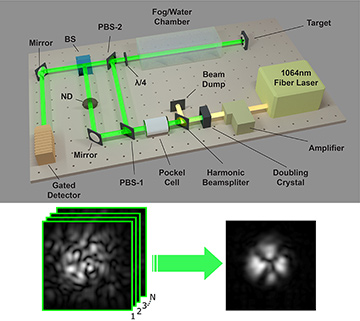 Top: Experimental setup of the time-gated holographic system. Bottom: Individual fields of a target “X” are extracted from 1,000 detected holograms and coherently combined to restore the image through turbid water at 13 attenuation lengths. [Enlarge figure]
Top: Experimental setup of the time-gated holographic system. Bottom: Individual fields of a target “X” are extracted from 1,000 detected holograms and coherently combined to restore the image through turbid water at 13 attenuation lengths. [Enlarge figure]
Imaging through extreme scattering environments, a fundamental challenge of modern optics, has experienced explosive research growth during the last two decades. Most advances to date have involved imaging problems at microscopic or mesoscopic scales. But many pressing practical imaging problems exist at macroscopic scales—for example, imaging through turbid water and fog, which are critical to navigation and situational awareness.
In these examples, the limited number of unscattered or ballistic photons that reaches a detector restricts the imaging range and significantly impairs image contrast. Consequently, macroscopic imaging through scattering media is generally addressed by separating ballistic photons from scattered ones using space, time, coherence, or polarization properties of light. This year, we reported a technique for using holographic measurement to help achieve that photon separation and thus address problems of imaging in strongly attenuating, macroscopic scattering media.1
Time gating is a classic approach to separating ballistic photons from scattered or delayed photons, and has achieved record ranges in sensing underwater and through fog.2,3 Extending the capabilities of time-gating systems, such that they can operate in a weak-signal regime where only a few ballistic photons are available, however, requires additional mechanisms to reject scattered photons and to amplify the weak signal buried in the noise.
Our work has shown that coherently averaging multiple time-gated holograms provides the means to achieve this goal.1 Holographic measurements implicitly apply coherence gating, which serves as another mechanism to reject scattered photons, and a high-power reference beam offers the necessary signal gain. However, this strong holographic amplification introduces shot noise, which can exceed the weak return signal by orders of magnitude. Therefore, another mechanism for improving signal-to-noise ratio (SNR) has to be invoked: multi-measurement coherent averaging.
Holographic measurements provide access to the electromagnetic fields rather than intensities, enabling one to apply multi-measurement averaging coherently. Using coherent averaging guarantees a faster SNR increase with the number of processed images compared to incoherent averaging (1/n versus 1/n½), but requires accounting for random phase and amplitude shifts associated with each measurement. We developed numerical techniques for estimating these terms and coherently combining the holograms.
Our experiments showed that for highly reflective targets, the imaging range underwater and through fog can be extended to over 13 attenuation lengths by combining time-gating, holographic detection, and coherent multi-measurement processing. The core elements of the method are a novel signal model, numerical techniques for signal recovery, and extensive experimentation demonstrating imaging through dynamically evolving, macroscopic scattering media.
Researchers
A.V. Kanaev, A.T. Watnik, D.F. Gardner, K.P. Judd, P.S. Lebow and J.R. Lindle, U.S. Naval Research Laboratory, Washington, D.C., USA
C. Metzler, Rice University, Houston, Texas, USA
K.M. Novak, Tekla Research, Dumfries, Va., USA
References
1. A. Kanaev et al. Opt Lett. 43, 3088 (2018).
2. F. Dalgleish et al. Marine Technol. Soc. J. 47, 128 (2013).
3. A. Maccarone et al. CLEO, OSA Technical Digest, paper SF2M.2 (2017).

